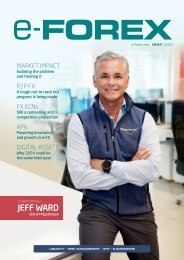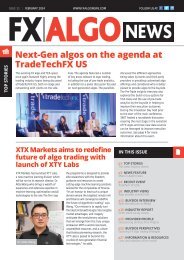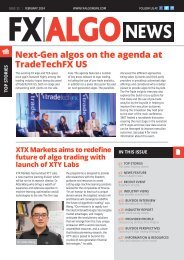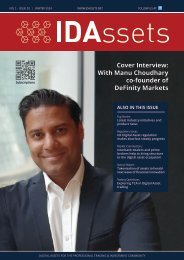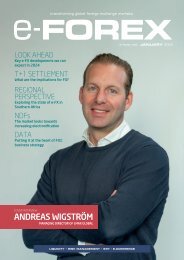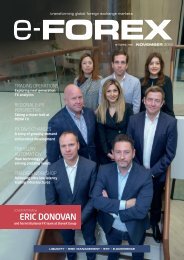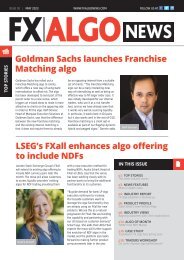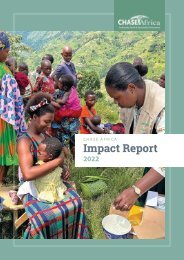Create successful ePaper yourself
Turn your PDF publications into a flip-book with our unique Google optimized e-Paper software.
The Nordics: Demand for digital FX services is now focused on more sophistication through proven technology<br />
“API adoption continues to play a big role in the development<br />
of future-proof solutions going from the SMEs all the way to<br />
our largest corporates and financial institutions”<br />
much more fruitful and saved time<br />
for all market participants in defining<br />
what is acceptable behaviour and<br />
what is not.”<br />
REGIONAL E-FX PERSPECTIVE<br />
Carolina Trujillo<br />
Carolina Trujillo, Head of e-FX<br />
Distribution at SEB, explains that<br />
current trends point towards<br />
increasing demand for electronic<br />
sophistication, not just adoption.<br />
“At this stage, I see two main<br />
trends,” she says. “The first one is<br />
sophistication for some clients that<br />
are more conscious of different<br />
offerings, from established platforms<br />
or banks to fintech alternatives, and<br />
want to understand the implications<br />
of those choices, and when it is the<br />
right time for them to make those.<br />
This can mean anything from adding<br />
algos or share class hedging to your<br />
trading tools to rebuilding your<br />
infrastructure to make sure you have<br />
the best solution to fit your needs.”<br />
“The second trend,” she continues,<br />
“is the broadening of the scope<br />
of “electronic FX” from just the<br />
execution to pre and post-execution<br />
focusing on the automation of those<br />
components.”<br />
At first glance, one would think<br />
this demand can only be fulfilled by<br />
increasingly advanced technology.<br />
However, Matti Honkanen, Director,<br />
Head of NextGen FX at Nordea,<br />
doesn’t think so. “It is a common<br />
misconception that the ongoing and<br />
upcoming digital transformation<br />
will be driven by new emerging,<br />
revolutionary and unforeseen<br />
technologies,” he says.<br />
“Nordea’s position as one of the<br />
leaders in digital FX is not based on<br />
the extensive use of technologies, but<br />
on a smart and customer demanddriven<br />
use of unexciting technologies.<br />
We certainly try new technologies, but<br />
quite often we figure out the old tech<br />
can do the job better.”<br />
Given these trends, how are Nordic<br />
banks addressing customer needs and<br />
changing market regulations?<br />
REGULATORY CHANGES AND<br />
ADOPTION OF THE FX GLOBAL<br />
CODE<br />
The FX Global Code has been widely<br />
adopted by institutions worldwide,<br />
and the Nordics are not an exception.<br />
However, mirroring worldwide trends,<br />
some work remains to be done.<br />
“A very high ratio of the sell side is<br />
onboard but the adoption on the buy<br />
side is lacking,” Trujillo says. “SEB is<br />
very involved in the work done by the<br />
FX Global Code and it is surprising<br />
how some FX participants of large<br />
buy-side firms have not heard of the<br />
FX Global Code at all, so there is still a<br />
lot of work to be done there.”<br />
She points out that while the Code<br />
positions electronification as the best<br />
way forward, its true impact lies in<br />
clarifying grey areas in workflows. “All<br />
signatories of the FX Global Code have<br />
an interest in promoting it to their<br />
counterparties,” she says. “I would<br />
say that the main effect of the Code<br />
has been to clarify some grey areas<br />
or confirm which market practice to<br />
follow. This has made conversations<br />
While the Code’s adoption is a priority,<br />
of more urgency is adapting to the<br />
raft of regulatory changes FX has<br />
witnessed recently. Trujillo notes that<br />
global changes have had a far bigger<br />
impact than local ones. She cites<br />
a pertinent example. “One of the<br />
changes has been caused by SA-CCR.<br />
It affects the liquidity offering from<br />
some banks forcing a re-shuffle of<br />
main providers in the forwards and<br />
swaps space.”<br />
A need for constant electronic<br />
upgrades in response to regulatory<br />
changes is a trend underway in<br />
Scandinavia, reflecting the global<br />
market. Trujillo believes market<br />
participants must think deeply about<br />
the value they deliver to clients with<br />
tech upgrades versus the need to<br />
upgrade tech to keep pace with<br />
regulatory changes.<br />
“All global platforms must comply with<br />
so many different regulations,” she<br />
says. “This is forcing some of them<br />
to carry big upgrades that have an<br />
impact on all their clients including<br />
the Nordic sell-side and buy-side. The<br />
amount of tech resources needed to<br />
keep pace with regulatory changes is<br />
significant and needs to be carefully<br />
balanced with tech activities that<br />
deliver value to clients.”<br />
INNOVATIVE PRODUCTS AND<br />
TREASURY AUTOMATION<br />
Treasury automation is a good example<br />
of an activity delivering significant<br />
value thanks to electronification and<br />
technological adoption. Nordea’s<br />
Honkanen has kept a keen eye on<br />
developments in this space. He says<br />
automation is steadily progressing,<br />
with different market players at<br />
different places in the journey.<br />
24 MAY 20<strong>23</strong> e-FOREX




